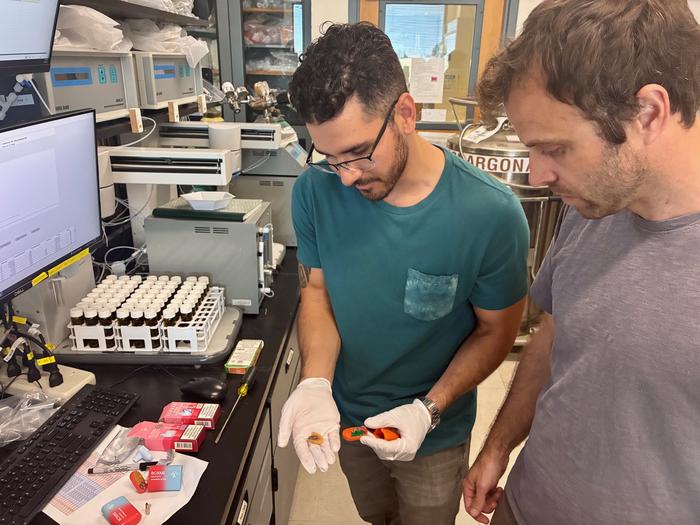
In recent years, the surge in popularity of disposable electronic cigarettes—sleek, compact devices resembling everyday items—has raised serious concerns among scientists and public health officials. Initially marketed as a cleaner alternative to traditional tobacco, these disposable vape pods now reveal a darker, more hazardous side. A groundbreaking study conducted by researchers at the University of California, Davis has evidenced that some disposable e-cigarettes emit significantly higher concentrations of toxic metals, including lead, nickel, and antimony, than both older e-cigarette models and conventional cigarettes. This revelation has serious implications for user health, particularly among the youth demographic that predominantly consumes these devices.
The study meticulously analyzed seven types of disposable e-cigarette products obtained from three of the most widely used brands, simulating between 500 to 1,500 puffs per device to mirror real-world usage patterns. Utilizing state-of-the-art instrumentation, the research team measured the concentration of various metals and metalloids that volatilize into inhaled vapor during device operation. The findings were deeply troubling: toxic elements such as lead and antimony were present in alarmingly high quantities, with metal concentrations escalating as the number of puffs increased. This suggests that the risk of exposure intensifies with continued use throughout the device’s lifecycle.
What sets disposable devices apart from earlier refillable e-cigarettes is a stark increase in metal emissions. Whereas previous models have exhibited moderate levels of contaminants, disposable e-cigarettes contain components that leach hazardous metals directly into their e-liquids, which then vaporize and become inhaled by the user. The research delineated the source of contamination: leaded bronze alloys within device hardware, such as heating elements and connectors, release nickel and lead into the fluid; meanwhile, heating coils contribute additional nickel emissions. Unused e-liquid samples themselves contained antimony at concerning concentrations, affirming that toxicity arises not just from hardware wear but also from the chemical milieu within these devices.
.adsslot_DnkzbZfiKl{ width:728px !important; height:90px !important; }
@media (max-width:1199px) { .adsslot_DnkzbZfiKl{ width:468px !important; height:60px !important; } }
@media (max-width:767px) { .adsslot_DnkzbZfiKl{ width:320px !important; height:50px !important; } }
ADVERTISEMENT
The health ramifications of inhaling these metals are profound. Lead, a well-documented neurotoxin, can impair cognitive development and nervous system function, especially in adolescents and young adults—precisely the market demographic for these disposable e-cigarettes. Nickel and antimony are recognized carcinogens with established links to respiratory system cancers. The study’s toxicological risk assessments revealed that vapor from several tested devices surpassed thresholds for both cancer and non-cancer health risks. For example, the lead emissions from one single disposable vape pod over a day’s use exceeded those produced by nearly twenty packs of traditional cigarettes, starkly illustrating the heightened exposure danger.
Beyond direct health impacts, this research illuminates regulatory challenges that arise from the rapid proliferation of disposable e-cigarette products in a poorly regulated marketplace. Despite the illegal status of most disposable e-cigarettes in the United States, these products remain readily accessible, often circumventing traditional oversight mechanisms. Their discreet design and colorful, innocuous appearance appeal to adolescents, who are particularly vulnerable to addictive substances and toxic exposures. The study’s findings underscore an urgent need for robust enforcement of existing regulations and the development of new policies tailored to this emergent public health threat.
Methodologically, the UC Davis study employed precise analytical chemistry techniques to quantify metal concentrations in vapor under controlled laboratory conditions. By activating the devices’ heating elements to simulate user inhalation, researchers collected vapor condensates which were then subjected to elemental analysis through methods such as inductively coupled plasma mass spectrometry (ICP-MS). This allowed for sensitive detection and quantification of trace metals and metalloids, yielding a detailed emission profile across the devices’ operational lifespan. The longitudinal approach—monitoring metal emissions over hundreds to thousands of puffs—highlighted the persistent and cumulative nature of toxic metal release.
The study also contributes to a growing body of evidence about the “life cycle” of disposable e-cigarettes, emphasizing how component materials degrade and interact chemically over time. The presence of leaded alloys, a known source of toxic metal leaching, raises vital questions about manufacturing standards and material selection. These findings challenge the prevailing perception that disposable vaping devices are inherently safer or cleaner than traditional tobacco products. Instead, the research reveals a hidden toxicological burden embedded within the product design itself, demanding scrutiny from manufacturers, regulators, and consumers alike.
This investigation drew attention to the broader implications of indeterminate exposure levels among an expanding consumer base. Since disposable e-cigarettes have flooded markets with hundreds of different brands and styles, comprehensive assessments are lacking for most products. The UC Davis work, though limited to a subset of devices, serves as a critical initial warning. It calls for systematic surveillance and expanded toxicological research to fully characterize the risks posed by disposables. Without such efforts, public health strategies risk falling behind an accelerating trend with potentially serious consequences for youth and adult users.
Public health authorities and policymakers are urged to interpret these findings as a signal to intensify regulatory action. Measures may include banning hazardous component materials, imposing stricter manufacturing controls, mandating full disclosure of product contents, and increasing awareness campaigns targeting vulnerable populations. Education around the dangers of toxic metal exposure from vaping is essential to counteract industry marketing and peer influence that normalize device use. The findings also stress the importance of environmental toxicology as an integral component of tobacco harm reduction research.
In conclusion, the study from UC Davis exposes an alarming and previously underappreciated facet of disposable e-cigarette use. Rather than presenting a safer alternative to smoking, these devices may amplify risks by delivering elevated doses of neurotoxic and carcinogenic metals. The convergence of product design, chemical composition, and user behavior creates a complex risk matrix demanding immediate scientific and regulatory attention. Continued interdisciplinary research will be vital to unravel the full scope of health impacts, as well as to inform effective policies that protect public health in the face of evolving nicotine delivery technologies.
Subject of Research: Toxic metal emissions and health risks from disposable e-cigarettes
Article Title: Elevated toxic element emissions from popular disposable e-cigarettes: sources, life cycle, and health risks
News Publication Date: 25-Jun-2025
Web References: http://dx.doi.org/10.1021/acscentsci.5c00641
Image Credits: Kat Kerlin, UC Davis
Keywords
Disposable e-cigarettes, vape pods, toxic metals, lead exposure, nickel toxicity, antimony carcinogen, environmental toxicology, youth vaping risks, electronic cigarettes, metal leaching, health risk assessment, nicotine delivery devices
Tags: disposable e-cigarettes health riskse-cigarettes vs traditional cigarettesenvironmental impact of disposable vapeslong-term effects of e-cigarette usemetal concentration in e-cigarettespublic health implications vapingtoxic metals in vaping productstoxic substances in inhaled vaporUniversity of California Davis studyvape device safety concernsvaping addiction among youthyouth vaping dangers



